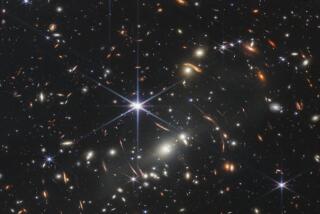Book Review : Universe That Knows What It’s Doing
The Cosmic Blueprint: New Discoveries in Nature’s Creative Ability to Order the Universe by Paul Davies (Simon & Schuster: $17.95; 232 pages)
From time to time in this space I have expressed impatience with views of reality that stray from the rational, testable and observable. Mysticism, in all of its guises, is to me no more nor less than belief in magic.
And yet, though I share the scientific world view, I am aware that despite the extraordinary accomplishments of science over the last few centuries, many basic questions remain unanswered: the nature of matter, the origin and development of the universe, the mechanism that drives evolution, and the workings of the brain and consciousness, to name a few.
These and many other fundamental issues are shrouded in mystery. In fact, in almost every field of inquiry, a persistent questioner does not have to ask too many questions before a researcher must honestly answer, “We don’t know.”
Traditional science is not much troubled by these gaps in knowledge. Scientists would like to know the answers, of course, but they believe that if they keep at it long enough and are clever enough in their research, ultimately they will. There is much historical evidence to support this faith in the primacy of the scientific method in the search for truth.
Unacceptable Alternative
Besides, the alternative view is unacceptable. Assertions of non-rational, non-physical, metaphysical causes and explanations for the real world leave them--and me--cold.
I have tried to consider such beliefs sympathetically, but I simply fail to understand what people who hold them are talking about. There is, after all, a difference between having an open mind and having holes in your head.
Which brings us to the book at hand, “The Cosmic Blueprint” by Paul Davies, a book that successfully charts a middle ground between the scientific and the non-scientific points of view. Davies, a professor of theoretical physics at the University of Newcastle-upon-Tyne in England, does this by enlarging the definition of science and by using reason to make his case.
Davies argues that the reductionist approach to science--which holds that everything is ultimately reducible to the laws of physics--is too limiting. “There must be new general principles--organizing principles over and above the known laws of physics--which have yet to be discovered,” he says. “We seem to be on the verge of discovering not only wholly new laws of nature, but ways of thinking about nature that depart radically from traditional science.”
The additional law of nature that Davies proposes is that the universe is basically self-organizing, that is, that chance alone does not and cannot explain the existence of matter or the existence of life. “The steady unfolding of organized complexity in the universe is a fundamental property of nature,” he writes.
This principle explains the existence of the universe that we observe, Davies says, and it also explains how life arose from inanimate matter and how it has evolved into ever-greater complexity over the billions of years of evolution.
“There are creative forces at work in matter that encourage it to develop life,” Davies asserts; “not vital forces or metaphysical principles, but qualities of self-organization that are not contained in--or at least do not obviously follow from--our existing laws of physics.”
What makes his approach worthy of consideration is that even though it rejects chance as the ultimate explanatory principle of the universe, it does not rely on a creator to explain all that we see around us. While Davies finds traditional science inadequate, he moves into the middle ground from the side of science rather than from the side of religion.
Make no mistake about it. Davies insists that science as generally understood cannot explain reality. For example, he finds the theory of evolution unbelievable. Even granting that billions of years is a very long time for accidents to have happened, life is too complex to have arisen by accident.
“Complex structures in biology are unlikely to have come about as a result of purely random accidents,” he says. “Even the simplest living things are stupendously complex. The replicative machinery of life is based on the DNA molecule, which is itself as structurally complicated and intricately arranged as an automobile assembly line. If replication requires such a high threshold of complexity in the first place, how can any replicative system have arisen spontaneously?”
The complexity of living and non-living matter implies to Davies that there is design in the universe. “The impression of design is overwhelming,” he concludes. But he stops short of asserting--at least in this book--that there is a designer.
Nonetheless, he comes close. “Science may explain all the processes whereby the universe evolves its own destiny, but that still leaves room for there to be a meaning behind existence.”
But that is a jump that does not follow from his argument. It may well be that there are more laws of physics than physicists have yet discovered, and it may even be that self-organization and a drive for complexity are among them.
Science can accommodate such laws, if they in fact exist, and it may prove fruitful to look for them, though Davies does not explain how physicists might go about doing it. But whether the universe has meaning is a different question altogether.


